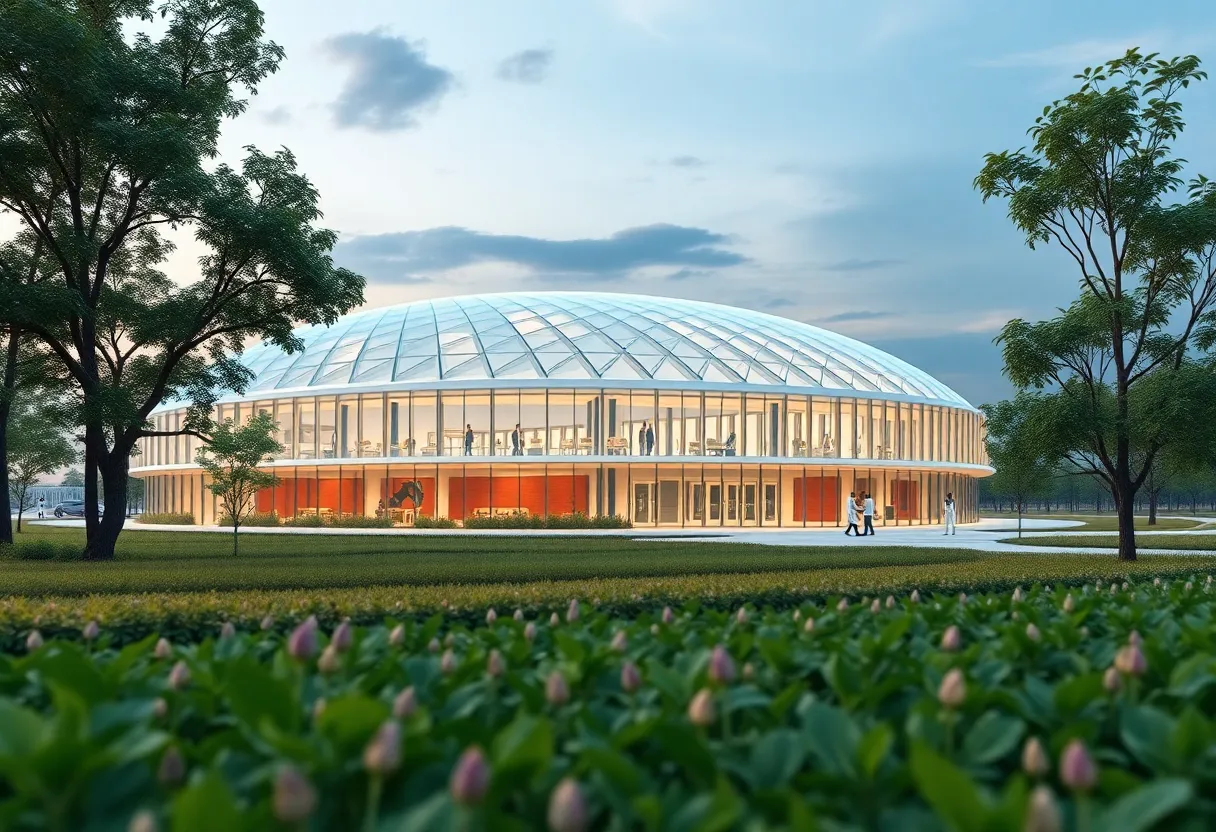Norman, OK, October 19, 2025
The University of Oklahoma in Norman has unveiled a $75 million biotech research center aimed at enhancing agricultural genomics. This facility will focus on developing drought-resistant crops, specifically wheat and corn, in collaboration with Monsanto and local farmers. Utilizing CRISPR technology, the center seeks to address climate challenges faced by Oklahoma’s agriculture. It is expected to create 150 research positions and support the local economy by reducing irrigation needs for farmers, further establishing Norman as a biotech hub in the Midwest.
Norman, OK – University of Oklahoma Launches $75 Million Biotech Research Center for Agricultural Genomics
In a major step forward for agricultural innovation, the University of Oklahoma in Norman, OK has launched a $75 million biotech research center dedicated to advancing agricultural genomics. Announced on October 19, 2025, the facility focuses on developing drought-resistant crops suited to Oklahoma’s unique climate challenges. This initiative partners the university with Monsanto and local farmers, aiming to enhance crop yields in the face of ongoing climate change pressures.
The center’s primary goal is to create more resilient staple grains, such as wheat and corn, through cutting-edge genetic modifications. By employing CRISPR technology, researchers plan to speed up gene-editing processes, allowing for quicker development of crops that require less water and withstand harsh environmental conditions. This approach addresses the growing need for sustainable farming solutions in regions prone to droughts, a common issue in Oklahoma and the broader Midwest.
Funding for the project combines state grants and federal USDA support, providing the financial backbone for its operations. As part of the rollout, 150 research positions will open soon, creating opportunities for scientists, technicians, and support staff. This expansion is expected to draw skilled professionals to the area, further solidifying Norman’s role in the biotech sector.
Impact on Local Farmers and Economy
For Oklahoma’s farming community, the center promises practical benefits, including reduced irrigation needs that could lower operational costs by up to 20%. Local farmers involved in the partnership stand to gain directly from these innovations, testing new crop varieties on their lands to ensure real-world applicability. This collaboration not only supports immediate agricultural needs but also positions the state as a hub for biotech advancements in the Midwest.
With Oklahoma’s agribusiness sector contributing $7 billion annually to the economy, the research center could amplify this impact by improving export capabilities and strengthening food security. Higher-yield, drought-resistant crops may lead to more stable production, benefiting both domestic markets and international trade. The initiative has already sparked interest from potential international collaborators, signaling broader global implications.
Public Outreach and Long-Term Vision
To ensure widespread adoption, the center includes public outreach programs such as workshops tailored for rural communities. These sessions will educate farmers on sustainable practices, emphasizing the integration of genomic technologies into everyday operations. By fostering knowledge-sharing, the university aims to build a network of informed stakeholders committed to environmentally friendly agriculture.
The launch comes at a critical time, as climate change continues to strain water resources and crop productivity across the region. Oklahoma’s variable weather patterns, including prolonged dry spells, have highlighted the urgency for such innovations. The center’s focus on tailoring solutions to local conditions underscores a strategic effort to mitigate these risks while driving economic growth.
Strategic Positioning for Norman
Norman’s selection as the home for this facility is no coincidence. The city’s proximity to vast farmlands and its growing reputation in research make it an ideal location. The university’s involvement ensures access to academic expertise, while partnerships with industry leaders like Monsanto provide the necessary technological and financial resources. Together, these elements are set to attract venture capital and top talent, potentially transforming the local economy.
Looking ahead, the center’s success could serve as a model for similar projects nationwide. By prioritizing crops vital to Oklahoma’s agriculture, the initiative addresses immediate challenges while laying the groundwork for future breakthroughs. Farmers and researchers alike anticipate that these developments will not only safeguard against climate uncertainties but also enhance the competitiveness of the state’s agricultural output.
In summary, the University of Oklahoma’s new biotech research center represents a pivotal investment in the future of farming. Through targeted genomic research, strategic partnerships, and community engagement, it tackles pressing issues in food production and sustainability. As the project progresses, its outcomes will likely influence agricultural practices far beyond Oklahoma’s borders, contributing to a more resilient global food system.
FAQ
What is the focus of the new biotech research center launched by the University of Oklahoma?
The center focuses on developing drought-resistant crops tailored to Oklahoma’s climate, using agricultural genomics to enhance staple grains like wheat and corn.
When was the biotech research center launched?
The center was launched on October 19, 2025, in Norman, OK.
How much funding supports the biotech research center?
The center is supported by a $75 million investment, including state grants and federal USDA support.
Who are the key partners in this initiative?
The University of Oklahoma partners with Monsanto and local farmers for the project.
What technology will the center use to develop new crops?
The center will employ CRISPR technology to accelerate gene editing for drought-resistant crops.
How many research positions will the center create?
The center will open 150 research positions soon.
What economic benefits does the center promise for farmers?
Farmers anticipate reduced irrigation needs, cutting costs by up to 20%.
What is the annual contribution of Oklahoma’s agribusiness sector?
Oklahoma’s agribusiness contributes $7 billion yearly to the economy.
What public outreach does the center include?
The center includes workshops for rural communities to promote sustainable farming practices.
How does this initiative position Norman?
This venture is poised to position Norman as a Midwest biotech leader, attracting talent and venture capital.
Key Features of the Biotech Research Center
| Feature | Description |
|---|---|
| Funding Amount | $75 million, including state grants and federal USDA support |
| Primary Focus | Developing drought-resistant crops tailored to Oklahoma’s climate for wheat and corn |
| Technology Used | CRISPR for accelerating gene editing |
| Partnerships | University of Oklahoma with Monsanto and local farmers |
| Job Creation | 150 research positions opening soon |
| Farmer Benefits | Reduced irrigation needs, cutting costs by up to 20% |
| Public Outreach | Workshops for rural communities on sustainable farming practices |
| Economic Impact | Supports Oklahoma’s $7 billion annual agribusiness sector, boosting exports and food security |
| Strategic Positioning | Positions Norman as a Midwest biotech leader, attracting talent and venture capital |
Deeper Dive: News & Info About This Topic
HERE Resources
OU Health Sciences Center Marks Milestone with New Lab Space
Oklahoma City Unveils $20 Million Medical Research Center
Oklahoma City Launches Innovative Tech Startup Incubator
Oklahoma City Tech Expansion Signals Job Growth
Oklahoma City’s Startup Ecosystem and Retail Recovery
Oklahoma City Council to Vote on $10 Million Incentives for Biotech Growth





